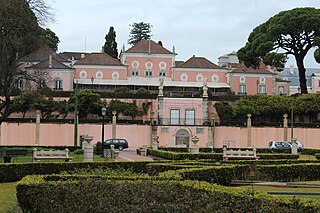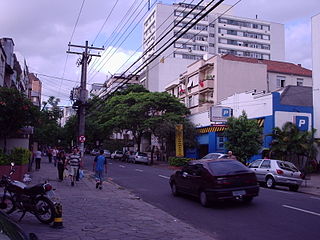Related Research Articles

Brasília is the federal capital of Brazil and seat of government of the Federal District. The city is located at the top of the Brazilian highlands in the country's Central-West region. It was founded by President Juscelino Kubitschek on 21 April 1960, to serve as the new national capital. Brasília is estimated to be Brazil's third-most populous city. Among major Latin American cities, it has the highest GDP per capita.

Petrópolis, also known as The Imperial City, is a municipality in the Southeast Region of Brazil. It is located in the state of Rio de Janeiro, 68 kilometres (42 mi) northeast of the city of Rio de Janeiro. According to the 2010 National Brazilian Census, Petrópolis municipality had 295,917 inhabitants that year, up from 286,537 inhabitants at the last census. Besides being the largest and most populous city in the Fluminense Mountain Region, the city also has the largest GDP and HDI in the region.

The National Congress of Brazil is the legislative body of Brazil's federal government. Unlike the state legislative assemblies and municipal chambers, the Congress is bicameral, composed of the Federal Senate and the Chamber of Deputies. The Congress meets annually in Brasília from 2 February to 22 December, with a mid-term break taking place between 17 July and 1 August.

Lúcio Marçal Ferreira Ribeiro Lima Costa was a Brazilian architect and urban planner, best known for his plan for Brasília.

The Belém Palace, formally the National Palace of Belém,, is the current official residence of the President of the Portuguese Republic, the head of state of Portugal. Located in the Belém District of Lisbon, the palace's main façade fronts the Praça Afonso de Albuquerque, facing the Tagus River. A former residence of the Portuguese Royal Family, the Belém Palace complex is made up of various buildings, wings, courtyards, and gardens, built variously from the 18th to 21st centuries.
An official residence is the residence of a head of state, head of government, governor, religious leader, leaders of international organizations, or other senior figure. It may be the same place where they conduct their work-related functions.

The Palácio do Planalto in Brasília is the official workplace of the president of Brazil. The building was designed by architect Oscar Niemeyer in 1958 and inaugurated on April 21, 1960. It has been the workplace of every Brazilian president since Juscelino Kubitschek. It is located at the Praça dos Três Poderes, to the east of the National Congress of Brazil and across from the Supreme Federal Court.

Bom Fim is a neighborhood in the city of Porto Alegre, the state capital of Rio Grande do Sul in Brazil. It was created by the law number 2022 from December 7, 1959.

The Palace of Freixo is a former-residence in the civil parish of Campanhã, in the northern Portuguese city of Porto.

The Itamaraty Palace, also known as the Palace of the Arches, is the headquarters of the Ministry of Foreign Affairs of Brazil. It is located in the national capital of Brasília. The building was designed by architect Oscar Niemeyer and inaugurated on April 21, 1970. It is located to the east of the National Congress building along the Ministries Esplanade, near the Praça dos Três Poderes.

The Palácio de Lahane, also known as the Palácio das Nobres, is a historic building in East Timor. As of 2022, its primary function was as a reception space for the East Timorese government.

The Palácio da Justiça is a historic building located in central Coimbra, Portugal, presently housing the city's Law Courts. It was formerly a religious house of the Dominican Order under the name College of St. Thomas and, whilst the private residence of the Counts of Ameal, was known as Palácio Ameal. Both of its former designations are still current in colloquial use.

Palácio dos Bandeirantes is a palace in São Paulo, Brazil. It is the seat of the São Paulo state government and the governor's official residence. The palace, located at the Morumbi district, also houses some secretaries and a wide historical and artistic exhibition open to the public.

The Project for the Royal Palace in Campo de Ourique was an ambitious 18th century proposal for a monumental royal palace to be built in the Campo de Ourique neighborhood of Lisbon. Portuguese architect Dionizio de S. Dionizio planned the palace for King Joseph I of Portugal as part of the reconstruction efforts following the destruction of the 1755 Lisbon Earthquake.
The 2020 Brazilian protests and demonstrations were popular demonstrations that took place in several regions of Brazil, in the context of the COVID-19 pandemic in Brazil. The protests began on March 15, 2020, with demonstrations in support of President Jair Bolsonaro, the target of several investigations, and against the isolation measures imposed by state governments.

The Governor of Mato Grosso do Sul is the head of government of the Brazilian state of Mato Grosso do Sul. It is a public position chosen through the two-round majority electoral system. If a candidate receives more than 50% of the total votes in the first ballot, he is elected without the need for a second round. But if no candidate obtains an absolute majority, a second round of voting would take place, where only the two candidates who obtained the most votes in the first round would participate. The winner of the second round would be elected governor. The legislature lasts 4 years and the governor has the right to re-election, without term limits.

The government of Mato Grosso do Sul is led by the Governor of Mato Grosso do Sul, Brazil, and is elected by the local population through popular suffrage and direct secret ballot for a four-year term. The current governor is Eduardo Riedel. Its seat is the governorate of Mato Grosso do Sul, which has been the seat of the government of Mato Grosso do Sul since 1983.

Rosiane Modesto de Oliveira is a Brazilian politician and teacher, is currently serving her first term as a federal deputy of Mato Grosso do Sul, she was previously Vice Governor of Mato Grosso do Sul from January 2015 to January 2019 in the government of Reinaldo Azambuja. It was between January 2015 and April 2016 Secretary of Human Rights, Social Assistance and Labor of Mato Grosso do Sul during the government of Reinaldo Azambuja.
References
- ↑ "Agente patrimonial invade prédio e ameaça detonar bomba em Campo Grande". G1 (in Brazilian Portuguese). Retrieved 2022-12-12.
- 1 2 "Servidores da Governadoria enfrentam oscilação de energia nesta manhã". Campo Grande News (in Brazilian Portuguese). Retrieved 2022-12-12.
- ↑ "Em meio a décadas e histórias, Parque do Poderes tem palácio "esquecido"". Campo Grande News (in Brazilian Portuguese). Retrieved 2022-12-12.
- ↑ "Zeca diz que entrega Governo sem obras inacabadas". www.douradosnews.com.br (in Brazilian Portuguese). Retrieved 2022-12-12.